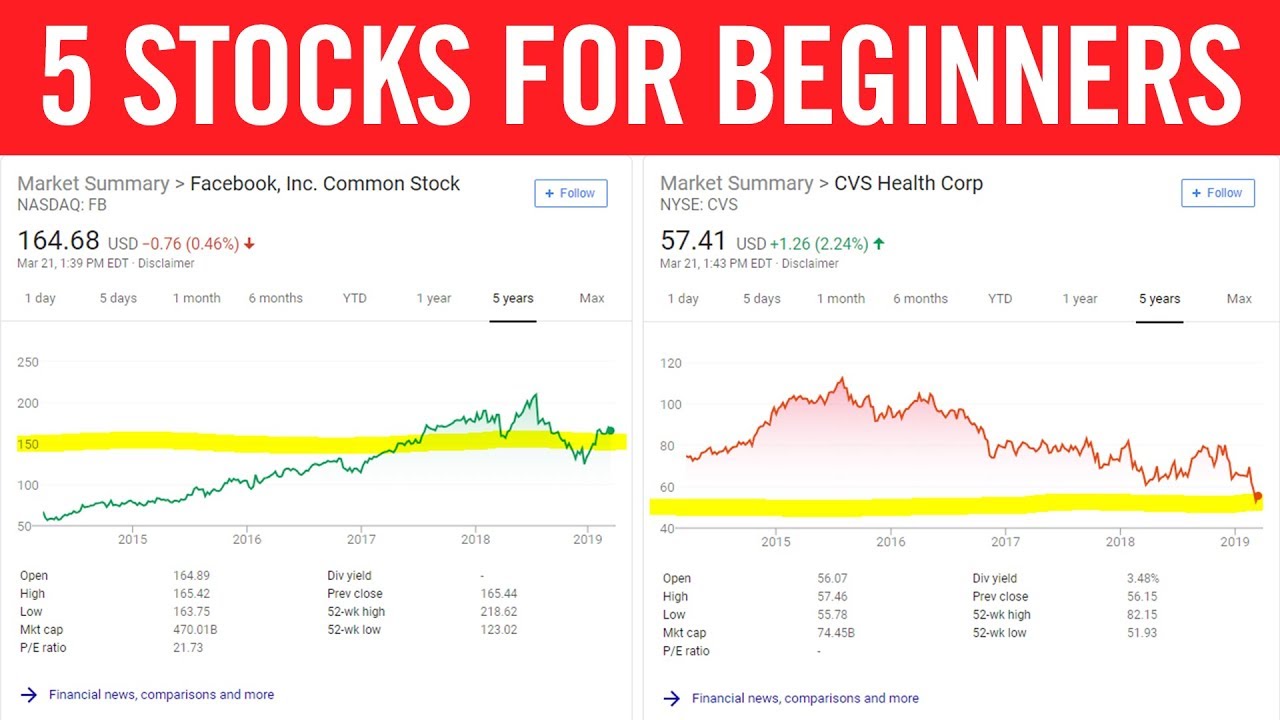Recommended Stocks for Investment Starters
-
Apple Inc. AAPL . This is a safe opportunity as a global technology leader with innovative products. I assume that Apple will continue to grow and offer good returns for novice investors. The current price is around $150 per share, and it has increased by approximately 100% over the past five years.
-
Microsoft Corp. MSFT. Microsoft is another reliable choice as it has demonstrated good growth in software and cloud services. The current price is around $280, and its stock has grown by more than 200% over the past five years.
-
Amazon.com Inc. AMZN . Amazon is known as the world’s leading online retailer and largest cloud provider. The current price is around $120, and although this company’s growth has slowed down recently, the long-term price might be significant.
-
Alphabet Inc. GOOGL . Google’s parent company is also a good option due to its strong growth in the search, advertising, and cloud businesses among other areas. The current price is around $120, and its stock has increased by more than 150% over the past five years.
-
Johnson & Johnson JNJ . As a major and reliable health care producer and provider, this company attracts small investors because of its steady growth and dividends. The current price is around $160, and it has had a stable increase in price over the past five years with continuous dividends that are significant for investors’ return.
-
Procter & Gamble Co. PG. This global leader in consumer goods manufacturing is also a typical choice for safe beginner investing. The current price is around $140, and many years of stable growth plus continuous dividends underpin the company’s business strategy.
-
Tesla Inc. TSLA . Tesla stock may be somewhat riskier due to its volatility; however, the company is the leader in electric vehicles and energy solutions. The current price is around $250, and it has added significant value over the past five years reflecting its disruptive business model and leadership in the respective markets.

Smart Investing Strategies for Beginners
Entering the stock market can be a thrilling yet overwhelming experience for beginners. The key to success lies in adopting smart investing strategies that align with your financial goals and risk tolerance. This guide will explore foundational investment principles, recommend some promising stocks for beginners, and explain why these stocks stand out.
Start with Blue-Chip Stocks
Blue-chip stocks represent companies that are leaders in their industries, known for their stability, reliability, and ability to navigate through various market conditions. Investing in blue-chip stocks can be a wise strategy for beginners because these companies often have a long track record of steady growth and sometimes pay dividends, which can provide a regular income stream in addition to potential stock price appreciation.
- Example: Consider Apple Inc. (AAPL), whose innovations in technology have not only revolutionized the way we live but have also provided consistent growth and returns for investors. With a market cap in the trillions and a history of delivering cutting-edge products, Apple’s stock has shown significant growth over the past decade, offering both stability and potential for appreciation.
Look for Dividend Growth Stocks
Dividend growth stocks are those that have a history of increasing their dividend payouts over time. They can be an excellent choice for beginners because they offer a dual earning potential: the appreciation of the stock price and the income from the dividends.
- Example: Procter & Gamble Co. (PG) is a prime example of a dividend growth stock, with a history of increasing its dividends for over 60 consecutive years. This kind of long-term growth can be especially attractive to beginners looking for reliable income alongside capital appreciation.
Explore the Potential of ETFs
Exchange-Traded Funds (ETFs) allow you to invest in a basket of stocks, diversifying your investment across many companies. This reduces the risk associated with investing in individual stocks and is a smart way to get exposure to entire sectors or indices.
- Example: The SPDR S&P 500 ETF Trust (SPY) mirrors the performance of the S&P 500, providing investors with a way to gain exposure to 500 of the largest U.S. companies. It’s an excellent way for beginners to diversify their portfolios with a single investment.
Consider the Power of Compound Interest
Understand and leverage the power of compound interest, which can significantly increase the value of your investments over time. Reinvesting dividends or the returns from stocks back into the market can accelerate the growth of your portfolio.
- Example: If you invested $10,000 in a stock with an average annual return of 8%, reinvesting the dividends, your investment would grow to over $46,000 in 20 years, showcasing the power of compound interest.
Research and Stay Informed
Before investing, conduct thorough research on potential stocks to understand their business models, financial health, and market position. Use reputable financial news sources and tools to stay updated on market trends and company performances.
- Example: Regularly checking financial news websites and using investment tools like Yahoo Finance or Morningstar can provide valuable insights into stock performances, helping you make informed decisions.
Set Long-Term Goals
Focus on long-term investing rather than short-term fluctuations. Stocks have historically provided substantial returns over the long term, and having a longer investment horizon can help mitigate the impact of short-term market volatility.
- Example: Investors who held onto their stocks through the 2008 financial crisis and the 2020 market downturn saw substantial recoveries and gains in the following years, underscoring the importance of patience and a long-term perspective.
Boldly embarking on your investing journey requires a combination of strategic choices, patience, and ongoing education. By starting with stable blue-chip stocks, considering dividend growers, exploring ETFs, leveraging compound interest, staying informed, and focusing on the long haul, you can set a strong foundation for your investment portfolio. Remember, the most successful investors are those who remain committed to their strategies through the ups and downs of the market.

Starting Small with Fractional Shares
For beginners, investing in the stock market can be a rather thrilling journey. One of the most interesting strategies that starting investors can try is dealing with fractional shares. With their help, novice investors can buy slices of stocks of high-value companies without paying a big sum of money. Thus, for a price of a trip to a café, one can become an owner of the piece of the favorite tech giant or an ambitious automotive innovator!
What Makes Fractional Shares So Great?
First and foremost, fractional shares investing makes purchasing shares accessible. You no longer need hundreds or thousands of dollars to buy a heavyweight stock – you can start with as little as $5 – $10 . Moreover, for such a small sum of money, you can already diversify your portfolio, spreading it across different sectors and reducing risks. Undoubtedly, the more diversified the portfolio is, the more stable returns become. This means that the strategy is viable, especially for beginners.
What To Invest
Tech Titans such as Apple and Microsoft represent a reliable sector with impressive growth potential. Historically, these companies have been rather stable and innovative, so returns on investments are usually just as good. For instance, the average annual return of Apple in the previous ten years was around 10% .
Consumer Staples, especially big companies like Procter & Gamble or Coca-Cola. The companies produce products that people use every day and can hardly refuse, so the demand is more or less stable even during economic crises. At the same time, Coca Cola has made regular dividend payments for more than 50 years, which means that the company combines growth with considerable income.
Green Energy is a relatively new sector but with truly amazing growth prospects. Companies such as Next Era Energy are leading the transition toward renewable energy, and the sector is soon bound to grow, considering the potential of extracting energy of the Sun and the wind.
How to Get Started?
To start investing, you need to take three simple steps:
-
choose a brokerage (there are a few on the Internet, offering fractional shares and having zero commission fees);
-
open an account (you will be asked to submit some basic information and, in some cases, no initial deposit is required);
-
start small (even one hundred dollars can be split in several stocks, so you can become a tiny shareholder of a few companies);
-
plan for growth (reinvest dividends and replenish your investments).
Why Avoiding Penny Stocks is Wise
Penny stocks, or stocks which are usually worth less than $5, are often marketed to new investors as a one-way ticket to wealth. Considering the bargain price and the option to buy many shares at once, an investor could reasonably assume that penny stocks are to be watched. The truth is, the risks are too high, and it is not worth gambling. Firstly, penny stocks suffer from a lack of liquidity. A small amount of trade relative to the demand might lead to a buyer’s market, that is to say that most loss or even no selling option is available at any given moment.
For instance, in case one had bought 10,000 shares of a company at $0.50, his or her investment would be worth $5,000. If there is no buyer available when one is looking to sell, the value of the investment could be brought to zero quite quickly. Moreover, equally important is the fact that most companies featured as penny stocks lack information. As per National Inflation Association, these companies do not have to file with the Securities and Exchange Commission, and there is hardly any information on these companies’ operations, products, and management. Thus, it is impossible to carefully execute the due diligence which could inform the decision to buy or avoid.
In addition, volatility characterizes penny stocks. It is not rare for prices of penny stock to swing widely from one mark to another in a matter of hours. For instance, the price of a stock could well go up by 50% in one day and fall by 75% the day after. As a prime example, numerous penny stocks have quite a history of attracting pump-and-dump schemes which aim to mislead new investors into buying pumped-up stock which the fraudsters then sell and leave, leaving real investors with a useless stock.






